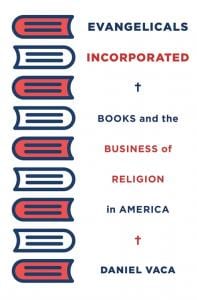Who are evangelicals? How did the meaning of evangelicalism take shape over the course of the last two centuries? When answering those questions, historians most commonly examine denominations, congregations, and parachurch ministries, and their leaders. Daniel Vaca, Robert Gale Noyes Assistant Professor of Humanities at Brown University, explores the creation and development of evangelical identity from a different vantage point, that of the marketplace. Vaca’s recently published book is Evangelicals Incorporated: Books and the Business of Religion in America (Harvard, 2019). We are grateful that he has stopped by The Anxious Bench to discuss this important book.
 JT: What do you mean by the “conjuring” of evangelical identities, and what role did publishing companies play in the creation of various public evangelicalisms?
JT: What do you mean by the “conjuring” of evangelical identities, and what role did publishing companies play in the creation of various public evangelicalisms?
DV: One of the principles at the heart of the study of religion is that social groups are not naturally occurring phenomena. Why do people join together, or not? With this in mind, a primary concern of my book is to ask how groups of Christians whom scholars commonly have recognized as evangelicals continually have been drawn together. To do that, I explore the cultural infrastructures that have made it possible for people to associate themselves—in practice, or in their imaginations—with others in new ways. Several of the book’s chapters focus on particular areas of infrastructural effort: trade associations, bookstores, corporate structures, marketing strategies, and more.
Publishing companies are fascinating because they are hubs of infrastructural creativity and initiative, and their commercial activity has not regularly received significant attention. Especially before the internet put practices of reading and consumerism online, the evangelical publishing companies that I examine published books and magazines, created chains of bookstores, established elaborate networks of churches and parachurch organizations, transformed evangelical leaders into celebrities, and welcomed readers into their cultural worlds through stores and by mail. Even though they are not as powerful as they once were, they still do much of this work. They retain power for the same reason they attained it in the first place: no central structures of authority unite evangelicalism. This means that publishers have served not simply as cultural curators or gatekeepers but as institutions that have enabled and propelled the incorporation of evangelicalism’s social body.
JT: At the outset, you profess yourself skeptical of regnant definitions of evangelicalism that hinge on a set of theological propositions. Instead, evangelicalism, like other publics, is a product of “active participation, attention, and imagination.” My question: does it make any sense to talk about an evangelical public prior to the 1940s?
DV: If the work of the historian is the work of interpretation, then our choices about the terms we use and the ways we use them ultimately depend on our goals. For as long as historians have used sets of theological propositions to try to define evangelicalism, that approach has had at least three limitations. It minimizes people, places, and practices that don’t seem to embrace or express the propositions adequately. It makes it difficult for scholars to consider the many other ways and reasons that people associate with each other—including the “participation, attention, and imagination” you mention. And it treats theological propositions themselves as evidence of evangelicalism’s coherence and continuity. But it’s always possible for someone to accept any or all of these limitations, depending on their goals. I am skeptical primarily when theological propositions and their limitations are presented as some sort of objective index of evangelical identity rather than what they really are—interpretive claims, made with particular priorities in mind.
This has been a long way of approaching your question, to which I say: sure, it makes sense to talk about evangelicalism before the 1940s. But scholars shouldn’t pretend that the term “evangelical” has ever been anything but an instrument of interpretation—for scholars as well as evangelicals themselves. As you suggest, historians have noted that the term became prominent beginning especially in the 1940s, when fundamentalist leaders decided that they needed to rebrand their coalition. But as those 1940s “neo-evangelicals” themselves noted, the term had been used throughout the nineteenth century. Usage varied, but it’s fair to say that people often used the term to refer collectively to people that seemed to share their own sensibilities and subjectivities. In other words, it was a term used to signal that someone was the right kind of Christian—or even the right kind of person—beyond attachments to particular ecclesial institutions. For avowedly “evangelical” institutions in the nineteenth century no less than the 1940s, it was a way of branding themselves for their ideal audiences.
The bigger question for me is how to talk about all of the people who participate in evangelical cultures occasionally, or who might read a popular evangelical book and imagine themselves as part of its public yet not do much beyond that. As evangelical media companies note, these people are essential to the growth of the evangelical market throughout the United States and wider world. Are these people evangelicals? Since my task was to make sense of the market for evangelical media, I thought it was important to think about all consumers of evangelical media as participants in evangelicalism an as members of evangelical publics.
JT: In the last several decades of the twentieth century, how did evangelical publishing houses embrace market segmentation?
DV: The rise of market segmentation emerges out of a longer story about the commercial imperative to expand markets and profits. As I explore in the book’s last chapter, strategies of market segmentation or “niche marketing” took shape in the middle of the twentieth century as companies became more adept at identifying sets of consumer preferences and tailoring products to seemingly distinct consumer constituencies. Segmentation was a way of engaging gaps in the mass market, and it made sense to evangelical media companies, in part, because it relied on social scientific ideas and methodologies that missionaries had developed for decades in order to figure out why some people had not seemed interested in Christianity.
Beginning especially in the 1970s and 1980s, evangelical publishing companies embraced segmentation strategy in a variety of ways. First, they applied segmentation strategy to bibles, creating bible translations and editions tailored to evangelical consumer constituencies. But then they also decided that segmentation was a way for them to try to reach markets they had previously ignored, including African American evangelicals and Latinx evangelicals. While these efforts diversified the range consumers that evangelical companies addressed overall, segmentation also perpetuated racialized divisions by effectively transforming segregation into a business strategy. By incentivizing companies to invest in their most successful niches, segmentation also led evangelical companies to focus their commercial attention on market segments tailored to white political and social conservatives.
I ended up devoting a whole chapter to market segmentation after discussing it relatively briefly in a talk several years ago. Pushing me to sharpen what I had just said, a perceptive colleague—Pamela Klassen (University of Toronto)—asked: “Is market segmentation heretical?” That is, doesn’t segmentation undermine the commonly proclaimed ideal of Christian unity? I share this question because it inspired me to think a lot more about the social effects of business strategies and commercial technologies. I pursue this preoccupation especially in the book’s chapter on evangelical women and retail practices, and it continues to shape how I think about the future of evangelical consumerism in an age when “heretical” algorithms feed us recommendations for products tailored to our apparent preferences.
JT: At various points in Evangelicals Incorporated, you discuss the fact that whiteness is a key component of the evangelical identity forged through the marketplace. How so?
DV: I think that groups of evangelicals have tended to be made up of people who identify the religious practices and social concerns of other ostensible evangelicals as their own. Their political identities include perceptions of race, class, and gender. By identifying themselves as “evangelical,” survey respondents (e.g., the 81% of white evangelicals who purportedly voted for Donald Trump) often are identifying themselves as a particular kind of person, as opposed to simply marking themselves as a particular kind of Christian. It’s an example of a much longer evangelical preoccupation with reproducing a certain kind of person. And at least from the perspective of the institutions I examine, that person has usually been a white person.
The evangelical marketplace has nurtured evangelicalism’s whiteness through ideology and through infrastructure. I explore how a variety of evangelical institutions championed the ideal of theological “distinctiveness,” for example, and insisted upon its importance for their communities in a way that allowed whiteness to appear as the unintended consequence of doctrinal scrupulousness. The infrastructures I examine include everything from the presumed profile of the mass-market consumer to the suburban location of bookstores to editorial policies. Uniting all of this is the logic of commercialism itself. Evangelical authors, editors, booksellers, and everyone else in the industry continually have focused primarily on selling products to consumers who looked and felt familiar—who looked like people in and around the industry. That was the way to generate reliable revenue.
I argue that business strategies carry values and biases that are not always evident on corporate statements of purpose—and might not even be apparent to the people who put those strategies into practice. Just the other day, for example, I spoke with an evangelical publishing executive who said that he had not thought about the industry’s whiteness before reading my book. That surprised me, and I was glad to hear that I had helped bring some of his own presumptions and priorities into view.
But then I realized that this executive’s apparent commitment to addressing his industry’s limitations was itself a response to his sense that the market might reward attempts to elevate the voices of evangelicals who value racial justice, gender equality, and other progressive priorities. Some readers might view his hypothesis as a reason to have faith in the supposedly self-correcting power of markets. But this executive’s ability to pursue newfound ambitions ultimately will depend on the commercial viability of those ambitions. And that viability in turn depends on sets of ideology and infrastructure that have been more than a century in the making.












